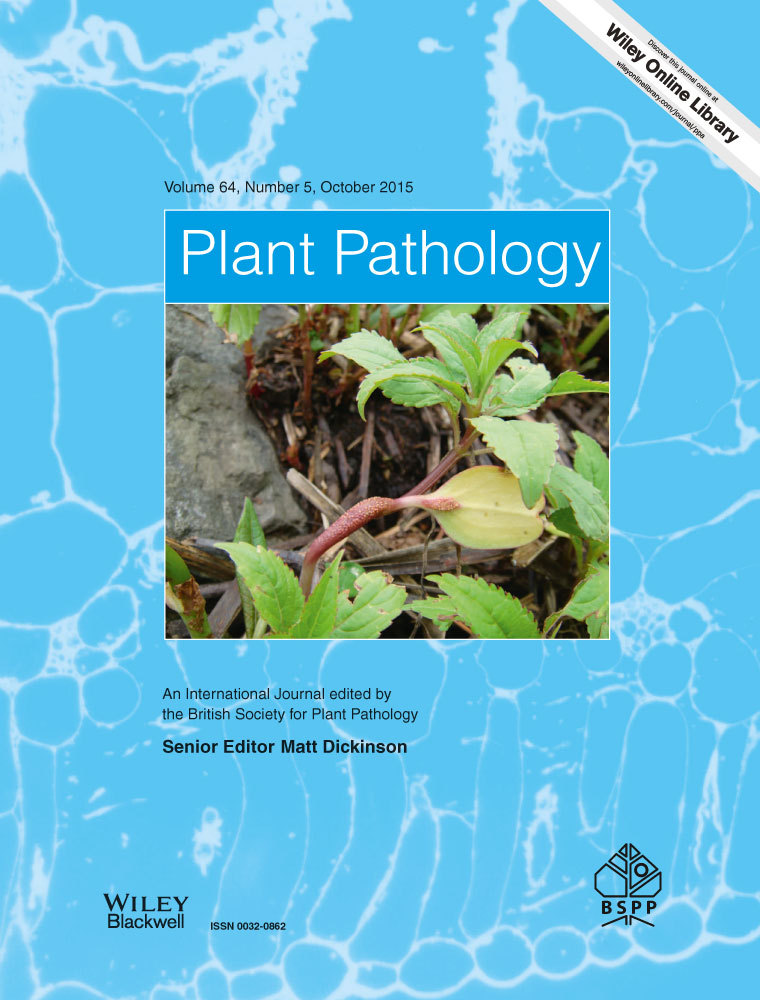Ver ítem
- xmlui.general.dspace_homeCentros Regionales y EEAsCentro Regional CorrientesEEA Bella VistaArtículos científicosxmlui.ArtifactBrowser.ItemViewer.trail
- Inicio
- Centros Regionales y EEAs
- Centro Regional Corrientes
- EEA Bella Vista
- Artículos científicos
- Ver ítem
A functional XopAG homologue in Xanthomonas fuscans pv. aurantifolii strain C limits host range
Resumen
Citrus canker is caused by two Xanthomonas species, Xanthomonas citri, which has become the primary pathogen
where citrus canker occurs (type A citrus canker, Xc-A), and X. fuscans pv. aurantifolii (Xfa), which consists of strains
B and C. The B strain is less pathogenic than the A strain, but produces symptoms in all citrus species. The C-type cankers
only infect Key lime (Citrus aurantifolia) and produce a hypersensitive reaction (HR) in grapefruit
[ver mas...]
Citrus canker is caused by two Xanthomonas species, Xanthomonas citri, which has become the primary pathogen
where citrus canker occurs (type A citrus canker, Xc-A), and X. fuscans pv. aurantifolii (Xfa), which consists of strains
B and C. The B strain is less pathogenic than the A strain, but produces symptoms in all citrus species. The C-type cankers
only infect Key lime (Citrus aurantifolia) and produce a hypersensitive reaction (HR) in grapefruit (Citrus paradisi)
leaves. An avirulence gene, avrGf2, was identified in a C strain that was responsible for the HR in grapefruit. AvrGf2
is a member of XopAG effector family and shares 45% identity at amino acid level with another member of the same
family, AvrGf1 from strain Xc-Aw, which was previously shown to elicit an HR in grapefruit. AvrGf2 shares sequence
identity with other XopAG effectors present in Xanthomonas vasculorum, Xanthomonas campestris pv. musacearum
and Pseudomonas syringae pv. tomato. Mutagenesis of avrGf2 in C strain resulted in a compatible reaction in grapefruit.
There was no observable effect on virulence when Xc-A transconjugants containing either avirulence gene were
inoculated on Key lime. Expression of avrGf1 or avrGf2 in Xc-A resulted in a similar phenotype following infiltration
into grapefruit leaves, although the avrGf2 transconjugant elicited a faster HR and lower populations than the transconjugant
containing avrGf1. Also, it was shown that all Xfa-B strains tested contain a transposon in avrGf2 that helps
to explain the differences in host range between B and C strains.
[Cerrar]

Autor
Gochez, Alberto Martin;
Minsavage, Gerald V.;
Potnis, Neha;
Canteros, Blanca Isabel;
Stall, Robert E.;
Jones, Jeffrey B.;
Fuente
Plant pathology 64 : 1207–1214. (2015)
Fecha
2015
Editorial
British Society for Plant Pathology
ISSN
1365-3059 (Online)
Formato
pdf
Tipo de documento
artículo
Palabras Claves
Derechos de acceso
Restringido
 Excepto donde se diga explicitamente, este item se publica bajo la siguiente descripción: Creative Commons Attribution-NonCommercial-ShareAlike 2.5 Unported (CC BY-NC-SA 2.5)
Excepto donde se diga explicitamente, este item se publica bajo la siguiente descripción: Creative Commons Attribution-NonCommercial-ShareAlike 2.5 Unported (CC BY-NC-SA 2.5)

